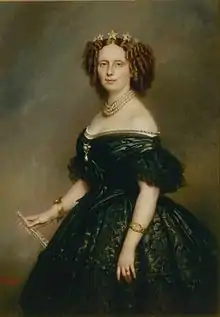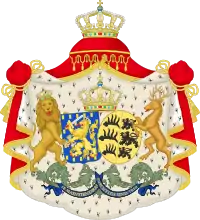Sophie of Württemberg
Sophie of Württemberg (Sophia Frederika Mathilde; 17 June 1818 – 3 June 1877) was Queen of the Netherlands as the first wife of King William III.[1]
| Sophie of Württemberg | |||||
|---|---|---|---|---|---|
 Portrait by Franz Xaver Winterhalter (1861) | |||||
| Queen consort of the Netherlands Grand Duchess of Luxembourg Duchess of Limburg | |||||
| Tenure | 7 March 1849 – 3 June 1877 | ||||
| Born | 17 June 1818 Ludwigsburg Palace, Stuttgart, Württemberg | ||||
| Died | 3 June 1877 (aged 58) Huis ten Bosch, The Hague, Netherlands | ||||
| Burial | 20 June 1877 Nieuwe Kerk, Delft, Netherlands | ||||
| Spouse | |||||
| Issue | |||||
| |||||
| House | Württemberg | ||||
| Father | William I of Württemberg | ||||
| Mother | Catherine Pavlovna of Russia | ||||
Biography
She was born in Stuttgart; her parents were King William I of Württemberg and Grand Duchess Catherine Pavlovna of Russia, the fourth eldest daughter of Tsar Paul I. Shortly after Sophie’s birth, her mother died, and she was cared for by her aunt, Catharina of Württemberg. She was niece of tsars Alexander I and Nicholas I of Russia.


Prior to her marriage, King Otto of Greece and Duke William of Brunswick were possible suitors for Princess Sophie. The engagement with the first came to nothing because Princess Sophie's ambitious father had no confidence in the newly established Greek monarchy of Otto. Chance prevented a proposal by the second candidate because her father let it be known that Princess Sophie was already betrothed.
She married her maternal first cousin, the future Prince of Orange (later King William III), in Stuttgart on 18 June 1839 with the idea that she would in the end succeed in dominating him. The couple returned to the Netherlands and established themselves at the Plein Palace and—after they had become king and queen—at the Noordeinde Palace. They had three children. The marriage was not a success. King William's mother, whom he completely relied on, was totally against the marriage to a daughter of the sister she loathed and treated her daughter-in-law and niece with disdain. Intellectually, Queen Sophie was superior to her husband. She, on the other hand, did not fit his sensual character. While he loved contemporary painting, music and theatre, she was a lady of letters with a specific interest in history. William III had several extramarital relations. She let it be publicly known that she found him inferior and unsuitable to be king and that she would do better as a regent for her son.

Queen Sophie tried to separate from him, but this was refused; the state interest had to prevail. From 1855 the couple lived separately during the summer season, he at Het Loo Palace and she at Huis ten Bosch Palace. She also spent time in Stuttgart, with her own family. Queen Sophie died at Huis ten Bosch Palace in the Hague. She was buried in her wedding dress, because, in her own view, her life had ended on the day she married.
Queen Sophie corresponded with several European scholars and maintained warm ties with Emperor Napoleon III and Queen Victoria. She protected and stimulated the arts, supported several charities, including animal protection and construction of public parks. She was the 540th Dame of the Royal Order of Queen Maria Luisa.
Issue
- Prince William (1840–1879), Prince of Orange from 1849 until 1879.
- Prince Maurice (1843–1850) died in childhood.
- Prince Alexander (1851–1884), Prince of Orange from 1879 until 1884.
Ancestry
| Ancestors of Sophie of Württemberg |
|---|

Honours
.svg.png.webp) Spain: Dame of the Order of Queen Maria Luisa, 2 March 1858[2]
Spain: Dame of the Order of Queen Maria Luisa, 2 March 1858[2].svg.png.webp) Kingdom of Saxony: Dame of the Order of Sidonia, 1872[3]
Kingdom of Saxony: Dame of the Order of Sidonia, 1872[3]
References
- Hamer, Dianne (2011). Sophie: biografie van Sophie van Würtemberg (1818-1877) op basis van brieven en dagboeken. Uitgeverij Verloren. ISBN 978-9087042011.
- "Real orden de Damas Nobles de la Reina Maria Luisa", Guía Oficial de España (in Spanish), 1876, p. 131, retrieved 16 October 2020
- Staatshandbuch für den Freistaat Sachsen: 1873. Heinrich. 1873. p. 155.
External links
| Wikimedia Commons has media related to Queen Sophie of the Netherlands. |
Sophie of Württemberg Born: 17 June 1818 Died: 3 June 1877 | ||
| Royal titles | ||
|---|---|---|
| Preceded by Anna Pavlovna of Russia |
Queen consort of the Netherlands Grand Duchess consort of Luxembourg 1849–1877 |
Vacant Title next held by Emma of Waldeck and Pyrmont |